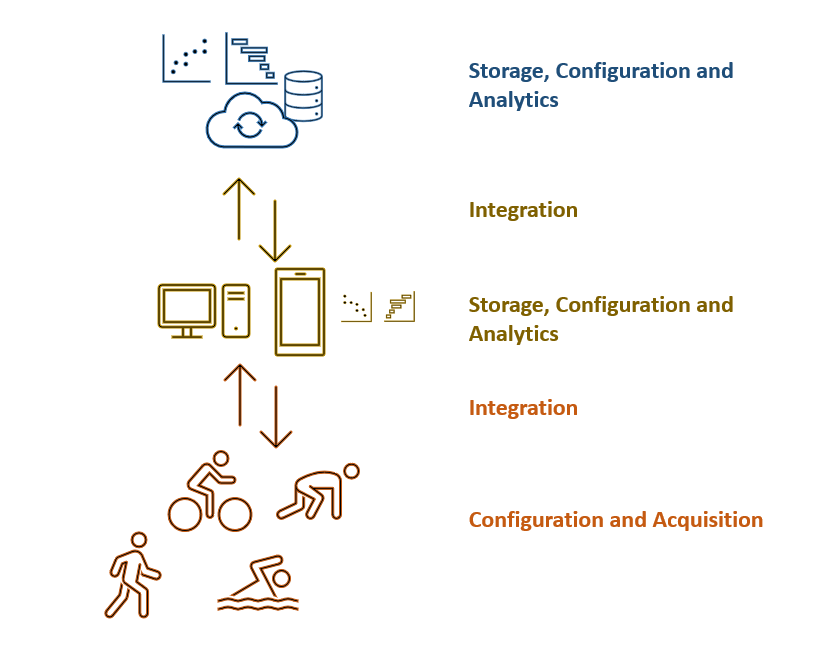I have many interests, however, two of them cross over when I consider Fitness Data, these are a love of analytics and exercise.
I have therefore decided to blog on the data we are creating and sharing when we use a wearable device. The categories below are based on wearables being a type of Internet of Things (IoT) device.
User Requirements
Reasons of users adopting wearable technology are varied but typically have one or more of the following components:
- Storing a record of exercise activity for posterity.
- Managing weight loss.
- Buying into the brand and make a lifestyle statement (i.e. Apple).
- Participating in a online community where users compare their activities (e.g. Strava).
- Acquiring the necessary data to support training activity with the goal of maintaining/improving fitness levels.
- Reduced insurance premiums offered by insurers if a user wears a fitness device and provides them access to the data. This of course comes with a range of issues that will be discussed in the Risks section.
Device Types
Common types of wearable technology include:
- Fitness Trackers to count steps taken, heart rate, etc.
- Smart watches in the form of an Galaxy Watch or similar which are able to deliver fitness tracker features along with a range of other features like web browsing, messaging, etc.
- Implantables to monitor conditions like hyper tension and type-2 diabetes.
Transducers
The data recorded by the device is typically acquired via the following types of transducers:
- GPS to measure distance traveled
- Heart rate monitor (chest or wrist)
- Accelerometer to record steps taken
In addition, sport specific transducers can be added, examples for cycling include:
- Cadence
- Power meters
Dimensions and Measures
Transducers within the device enable the capture, or calculation, of the following types of measurements
- Heart Rate
- Cycling Cadence
- Distance Traveled
- Height climbed
- Swim stroke rate
- Etc.
These are then combined with additional data entered by the user, for example:
- Height
- Weight
- Age
- Gender
Finally, algorithms are used to calculate measure like:
- Body Mass Index (BMI)
- Basal metabolic rate (BMR)
- Sleep quality
- Time spent in specific heart rate zones
- VO2 Max
- Calories burnt
Risks
Despite Data Quality issues, fitness data is incredibly valuable and personal. This presents several risks.
- Data collected and stored in the cloud may not be stored securely.
- If you lose a device, other parties can easily gain access to the information stored.
- Other parties can gain information on your physical location. There have been examples of:
- military locations being exposed by personnel wearing fitness trackers.
- ex partners tracking down a spouse and assaulting them.
- Fitness apps can collect information for marketing purposes, this is particularly concerning when combined with other datasets.
- Insurers are providing users incentives to share their fitness data. There are concerns about how this data will be used in the future and whether the users policy may become invalid if they stop providing the data.
Data Quality
The accuracy of what is measured can vary dramatically, depending on the device type, quality of the device and method of measurement used, broadly:
- Heart rate measurement where is a chest strap is used more accurate than using a smart watch and sensor on the wrist.
- The BMR or calories used figures are at best an estimate. The calculation used is based on the users height, weight, gender, and age to arrive at an approximation.
- Step counting can be trusted, however it is dependent on the quality of the device and the wearers gait being ‘normal’.
- Distance measurement using GPS measurements are typically sufficiently accurate to be relied on. This is not the case if a pedometer is being used.
Integration
The data journey, from a wearable to the cloud can be described as follows:

What is not shown here are the opportunities for users to migrate data between providers or modify data.
Standards
With regards to standards that help interoperability there are several in place as defined here. The are focused on topics like wireless connectivity (WPAN, WBAN, etc.), security standards, architecture, etc. not data exchange.
Standards that are available to assist with the exchanges of data between vendors (e.g. moving data from Garmin to Fitbit) include the GPX file format. Other options are as follow:

Conclusion
When we look at wearables that are focused on fitness, we are faced with a wide range of devices that have various levels of accuracy when measuring activity.
Despite these issues, their place is firmly cemented in our lives and will remain so. Double digit, year on year, growth has been observed and there is little doubt that this trend will continue in the future.
So we are now faced with IoT devices that are collecting more data as each year passes that can provide great opportunities for the wearer to pursue their fitness objectives, but also, for 3rd parties to pursue theirs. How we enable, or control these two cases is imperative.
Referenced Content
https://iotdunia.com/wearable-fitness-trackers/
Wearable data analysis, visualisation and recommendations on the go using android middleware
Fitness tracker used to set health insurance premiums
How accurate are fitness trackers
iot-and-wearable-devices-how-standardisation-helping-drive-market-adoption


